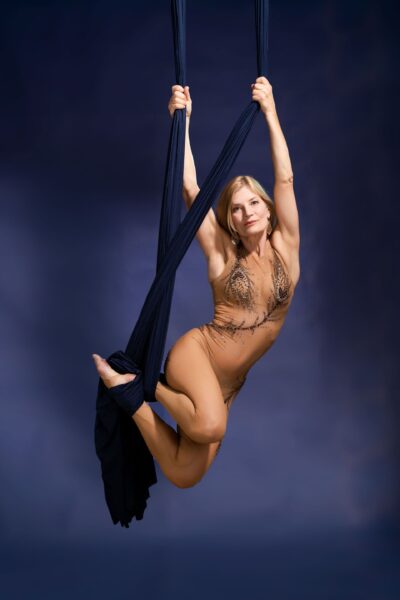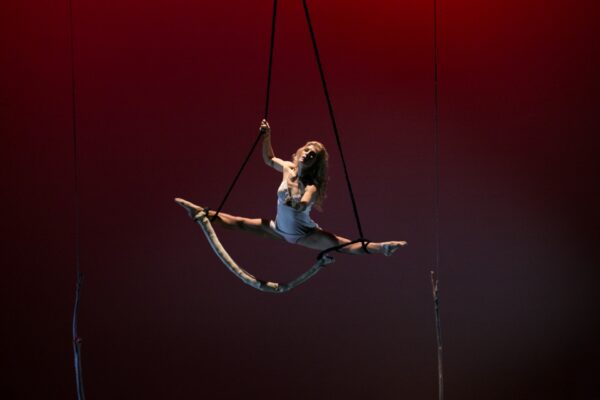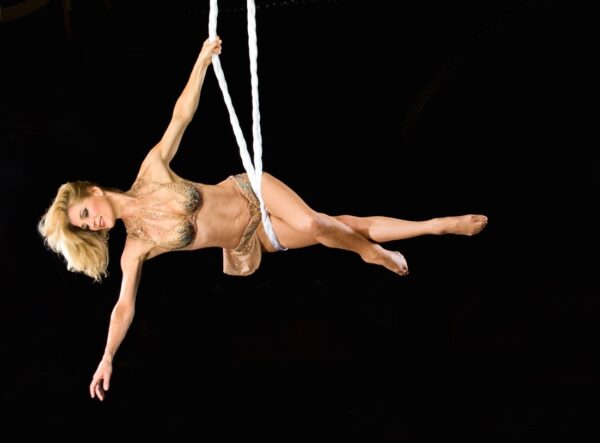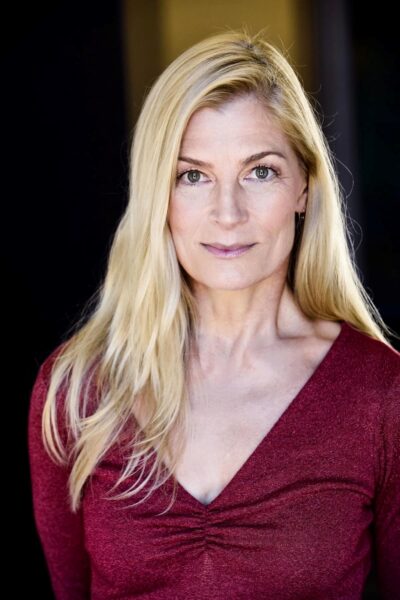CONFRONTING THE CURSE
It is a signal accomplishment to produce 70 minutes of solo theater which are all the things Hexen manages to be: solemn, playful, enchanting, insightful, and finally, deeply moving.
I first encountered Dreya Weber, the sole performer of Hexen (“witches” in German) at the bar before the show. When an exceedingly quirky old lady with a thick German accent, wandering about speaking of a “voman vith diamonds on her shoes and very big feet!” I had no idea that this voman, er, woman was really Hildegarde, the first of the three personages Weber plays in this show, directed by Rose Bonomo, a longtime friend and collaborator of Weber. Hildegarde told me not to cut in line and looked up at me from her hunched lowness and said, “You are very tall.”
Onstage in the semicircular Monroe Forum Theatre at the El Portal Theatre complex, Weber begins by dropping her cronish cloak and standing tall. Stepping into the rich-voiced splendor and instant winsomeness that is herself, she tells us about her mother, Jenny Trier (who happened to be in the house), a soprano singer whose talents are part of the show’s soundtrack, along with original compositions sung live by Weber.
Jenny told her daughter stories about witch-burnings in their ancestral Germany centuries ago; that, and a trip they took there, set Dreya searching. What was really at play in all that violence against women, the scapegoating of their bodies for misfortunes as varied as agriculturally menacing changes in the weather and sexual impotence? And who, after all, were these women?
But as Dreya says at the end of the show, “We don’t need witchcraft trials if we train women to disappear themselves.” In other words, there are many ways to erase women; thus, this is not a show about witches (which do not exist, at least the spell-casting fairytale types), nor about history, but about the repeated projection of fears and fantasies onto women’s bodies, and how the real women of the world are always unstoppably more interesting and varied than any role or place their culture might imagine for them.
Hildegarde, the old lady who shuffled about charming the audience before the show, is an old German figure of the 16th century. She tells us her story as we hear the sounds of night-creatures in the forest, where lone witches were said to gather hallucinatory herbs which deflated the male unterplatz, the meaning of which Hildegarde reveals in many moments of interactive hilarity.
After Hildegarde we meet Hypatia, a neo-Platonist philosopher, murdered by a Christian mob in 415 AD. Here, in another instance of stoking the fires of misogynistic accusation, we witness Dreya’s gifts as an aerialist. Telling the story of Hypatia’s insights and intellectual expansiveness, she twines herself within the rope hanging from the rafters, and twisting and spinning around, then rising elegantly to stand upright for a moment, she drops down and dangles from her ankles with arms extended, disclosing this painful history. The intimacy of the stage-space grants access to the rapture in Dreya’s face as she swirls and pirouettes aloft.
The third character is a modern personality, Cherry Rose. She wakes up onstage from a blackout, and in her risqué rapport with viewers, we learn she has been chosen for stardom (with certain sexual conditions) by a greedy manager. Dreya is hilarious here. Putting stuffers in her shirt, she says she’s “making cookies” and that “due to the venue’s constraints, I can’t offer my favorite tipple, chloroform and ether.” With top hat and cane, performing an epic number that sounds like it came from an MGM musical, she is history’s showgirl, the momentarily favored object of the male gaze, cast out as naught when that gaze turns away.
One of the most effective sequences is an aerial dance here, with Dreya simulating marionette lifelessness, her manager’s voice fee-fi-fo-fuming down from the speakers (“oh baby sweet baby”) and Dreya’s body swinging, staggering with all the futility of dominated exhaustion, the cane pinned by the rope straight up her back. The Cherry Rose segment ends with the reclamation of the name her mother gave her, Susanna, connecting back to Dreya’s own source of liberatory energy, her mother, and a claiming and an owning of ancestry, however violent.
Along this journey through time, and the same but changing story of condemnation and violence, Dreya Weber carves out possibility in the energy and excitement of performance itself. Hexen: An Ancestral Witch Play is not a history lesson, though it might benefit from more active drama — from a greater containment of itself as drama. Still it is consistently propulsive, and Dreya’s dancing, singing and storytelling populate the stage with a gripping variety of remembrance and joy. Her writing is also effective, a highlight being when Hildegarde tells us to hide our pain in the earth when it’s too much to keep in, because the earth will know what to do with it. And Hexen is just that tree of hope, grown from planted sorrow, a strong oak rising and twisting with all the unrestraint of bodies dancing in the air.
photos courtesy of the artist
Hexen: An Ancestral Witch Play
reviewed on November 22. 2024
El Portal Theatre, 5269 Lankershim Blvd. in North Hollywood
Hexen moves to NYC in 2025
for more info: Social Media: @dreya_weber




